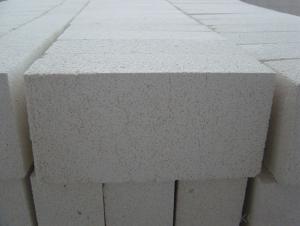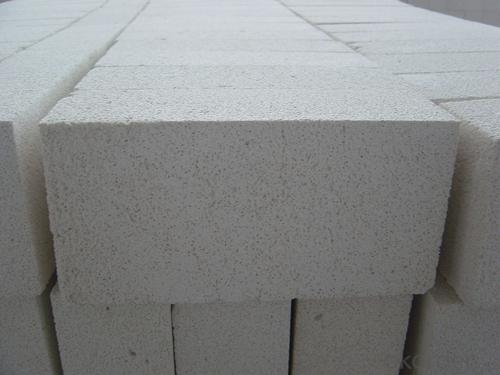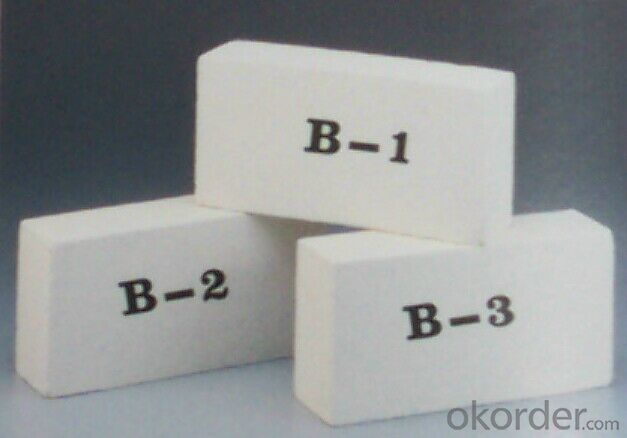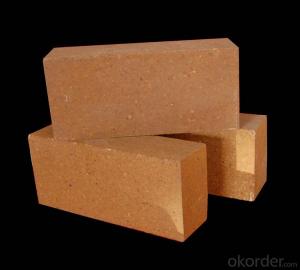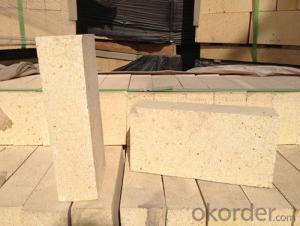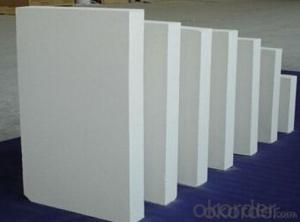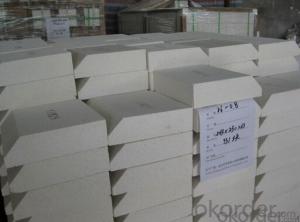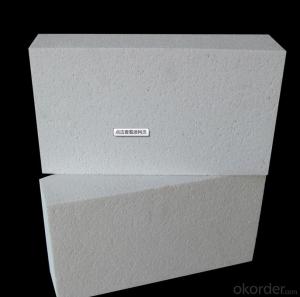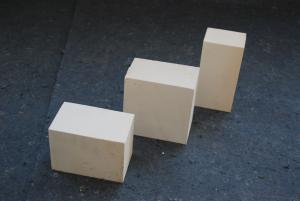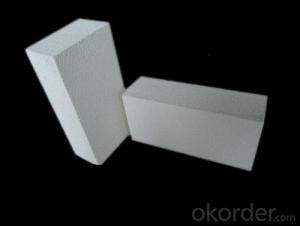Insulating Fire Brick - Refractory JM Mullite Insulation Brick B-5
- Loading Port:
- Shanghai
- Payment Terms:
- TT OR LC
- Min Order Qty:
- 10 m.t.
- Supply Capability:
- 1000 m.t./month
OKorder Service Pledge
OKorder Financial Service
You Might Also Like
Specifications
Low density.
2. Classification temperature:1610-1780.
3. Thermal insulation energy-saving effect is good.Refractory mullite insulating refractory brick JM 23
Okorder series heat insulation brick
Okorder series thermal insulation brick is an effective, energy saving, low carbon, environmental protection advanced, according to the ASTM standard manufacturing products. Okorder series products are best Li Ning and insulation in all types of industrial furnaces in the metallurgical field, aluminum, petrochemical, electric power and glass ceramic materials. They can be used as part of the working layer of thermal insulation or non - melting. Products have been widely used in the following furnace, achieved satisfactory results.
Application of heat preservation brick
Metallurgical Industry: blast furnace, hot blast furnace, heating furnace, etc..
Petrochemical Industry: ethylene cracking furnace, hydrogen production furnace, primary reformer, heating furnace, etc..
Ceramic industry: roller kiln, kiln, etc..
Glass industry: glass furnace regenerator, etc.
Carbon industry: carbon furnace, etc..
Aluminum electrolysis industry: aluminum reduction cell, etc.
Other industries: tunnel kiln, shuttle kiln, etc..
Advantages of heat insulation brick
Low thermal conductivity: more porosity will bring good thermal insulation effect, energy saving.
High crushing strength: high crushing strength, volume stability.
Low heat storage: small heat storage to absorb more heat, energy-saving effect is obvious.
Gao Chundu: iron, alkali metal impurity content is low.
The precise size: Brick size processing precision, special shape cutting and grinding, accelerate the brickwork.
Insulating brick picture
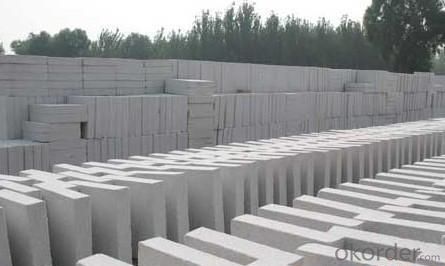
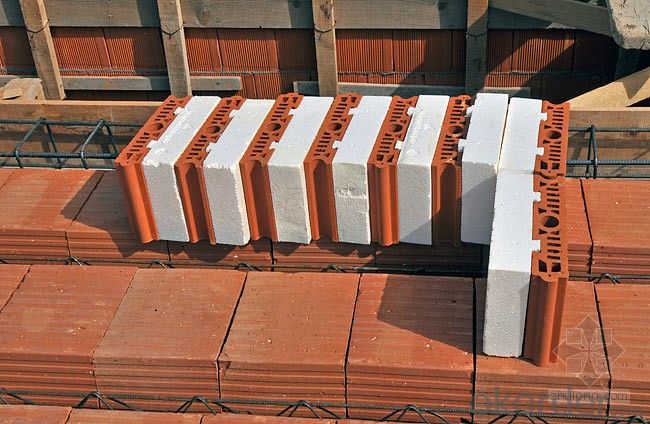
Common problem solutions
1. What products do you have?
We have all kinds of refractory bricks, refractory casting materials, mortar, cement, ceramic fiber products, etc..
Or you can browse our products to choose what you need.
2. How to control product quality?
With strict quality control system throughout the material selection and production process, we have the quality of refractory materials and ceramic fiber products to meet customer requirements.
From the selection of raw materials, the quality of our control to start. The quality certificate of the raw material is required, each batch of the products are to be tested in the use of the forward line. In the production process, the quality control by the workers, and then each piece of classification, and through the quality supervision and inspection.
3. Can you give me a brief introduction to the application of your product?
My company is mainly engaged in refractories in the steel, cement, glass, ceramics, petrochemical, electric power and other industries.
4. What information do you need if I need you?
In order to select the right products, we will provide us with information, such as the United States, technical data, order quantity, product application, etc..
If you have any questions, please contact us.
High alumina insulation brick,Insulation brick,Fireclay insulation brick
Features:
1. Low thermal conductivity.
2. High strength and resistance to corrosion.
3. Low heat capacity.
4. Low shrinkage after heavy firing.
5. High insulation.
6. High refractoriness.
7. Low density.
8. Good thermal shock resistance under high temperature.
9. Thermal insulation energy-saving effect is good.
Physical and chemical index:

Application:
Insulation brick can be widely used for lining or insulation layers of various industrial furnaces and kilns in metallurgical industry, machine building industry, ceramic industry, chemical industry.
- Q: Are insulating fire bricks easy to cut or shape?
- Compared to other bricks, insulating fire bricks offer a relatively simple cutting and shaping process. This is mainly because of their lower density and composition, enabling easier manipulation using standard masonry tools. However, it is crucial to acknowledge that the level of simplicity can differ depending on the specific type and brand of insulating fire brick. Some may demand special tools or techniques for cutting or shaping, while others may be more user-friendly. To ensure accurate cutting or shaping techniques, it is always advisable to refer to the manufacturer's instructions or seek professional guidance when working with insulating fire bricks.
- Q: Can insulating fire bricks be used in high-temperature kilns for pottery?
- Yes, insulating fire bricks can be used in high-temperature kilns for pottery. Insulating fire bricks are specifically designed to withstand high temperatures, typically up to 3000°F (1650°C). These bricks have low thermal conductivity, which means they can effectively retain heat and provide insulation in kilns. Using insulating fire bricks in high-temperature kilns can help maintain a consistent temperature throughout the firing process, ensuring that the pottery is properly heated and cooled. Additionally, these bricks are lightweight, which makes them easier to handle and install in kilns. Overall, insulating fire bricks are a suitable choice for high-temperature kilns used in pottery.
- Q: Can insulating fire bricks be used in high-temperature insulation panels?
- Yes, insulating fire bricks can be used in high-temperature insulation panels. Insulating fire bricks are designed to withstand high temperatures and provide excellent thermal insulation. They are made from lightweight refractory materials that have low thermal conductivity, allowing them to effectively reduce heat transfer. These bricks can be used in various applications, including furnaces, kilns, and high-temperature insulation panels. They are capable of withstanding temperatures up to 3000°F (1650°C) and can effectively retain heat, making them an ideal choice for high-temperature insulation panels.
- Q: Can insulating fire bricks be used for high-temperature applications?
- Insulating fire bricks are widely employed for applications involving high temperatures. These bricks have been crafted to offer exceptional thermal insulation and endure extreme temperatures. Depending on the specific type and composition of the brick, they can typically withstand temperatures of up to 2600°F (1427°C) or even higher. Kilns, furnaces, and industrial settings that necessitate high temperatures commonly utilize insulating fire bricks. These bricks are renowned for their minimal thermal conductivity, which aids in reducing heat loss and enhancing energy efficiency. Moreover, these bricks possess the advantages of being lightweight, long-lasting, and resistant to thermal shock, rendering them ideal for environments with elevated temperatures.
- Q: How durable are insulating fire bricks?
- Insulating fire bricks are known for their exceptional durability and longevity. These bricks are made from high-quality refractory materials, such as alumina and silica, which possess excellent thermal resistance and mechanical strength. As a result, insulating fire bricks can withstand extreme temperatures ranging from 1300°C to 1800°C (2372°F to 3272°F) without losing their structural integrity. The durability of insulating fire bricks can be attributed to several key factors. Firstly, their low thermal conductivity allows them to effectively insulate heat and prevent thermal shock, which is crucial for ensuring their long-term durability. Additionally, the high melting point of the refractory materials used in their production contributes to their ability to withstand intense heat. Moreover, insulating fire bricks are resistant to chemical erosion and corrosion, making them suitable for various industrial applications. They can withstand exposure to harsh chemicals, acids, and alkalis, ensuring their durability even in demanding environments. Furthermore, insulating fire bricks have a low density, making them lightweight and less susceptible to cracking or breaking under pressure. This characteristic enhances their durability and ease of handling during installation or maintenance. Overall, insulating fire bricks are highly durable and can withstand extreme temperatures, thermal shock, chemical erosion, and mechanical stress. Their exceptional durability makes them a preferred choice for applications such as furnaces, kilns, ovens, and other high-temperature environments where thermal insulation and long-lasting performance are essential.
- Q: Are insulating fire bricks resistant to acids and alkalis?
- The resistance of insulating fire bricks to acids and alkalis may vary depending on their composition and manufacturing process. Typically, these bricks are made from materials like alumina, silica, or a combination of both, which offer excellent resistance to high temperatures and thermal conductivity. Moreover, these materials are chemically inert, meaning they do not react with acids or alkalis. Nevertheless, it is important to acknowledge that certain acids and alkalis can still cause slight degradation or corrosion over time, particularly if they are highly concentrated or used at elevated temperatures. Therefore, it is advisable to refer to the manufacturer's specifications or conduct specific tests to determine the bricks' resistance level to particular acids or alkalis. In conclusion, insulating fire bricks are suitable for applications involving exposure to acids and alkalis. However, it is always recommended to consider the specific requirements and consult experts or manufacturers to ensure that the bricks will perform adequately in the intended environment.
- Q: Can insulating fire bricks be used in kiln car construction?
- Insulating fire bricks, which are manufactured using lightweight materials like ceramic fibers or lightweight refractory aggregates, can be utilized in the construction of kiln cars. These bricks possess exceptional insulating properties and have a low thermal conductivity, enabling them to effectively retain heat and prevent heat transfer to the outer surface of the kiln car. Incorporating insulating fire bricks into kiln car construction offers numerous advantages. Firstly, it aids in reducing heat loss, thereby enhancing energy efficiency and reducing fuel consumption. This benefit is especially significant in high-temperature applications such as kilns, where maintaining a consistent temperature is of utmost importance. Secondly, the utilization of insulating fire bricks helps safeguard the kiln car from thermal stresses and cracking. Due to the firing cycles, kilns experience substantial temperature fluctuations, and the presence of insulating fire bricks minimizes thermal shock, consequently prolonging the lifespan of the kiln car. Additionally, insulating fire bricks are notably lighter compared to conventional refractory bricks, making them more manageable and easier to install during kiln car construction. This, in turn, can result in cost savings related to labor and transportation expenses. However, it is crucial to note that insulating fire bricks possess lower strength and durability when compared to denser refractory bricks. Therefore, they are typically used in the hot face lining of kilns, while a more robust material is employed for the kiln car structure. In summary, the effective utilization of insulating fire bricks in kiln car construction can yield benefits such as improved energy efficiency, protection against thermal stresses, and overall enhancement of kiln performance.
- Q: Are insulating fire bricks suitable for commercial or industrial applications?
- Insulating fire bricks are indeed suitable for commercial and industrial applications. These bricks are specifically designed to withstand high temperatures and provide excellent thermal insulation. Due to their insulating properties, they are commonly used in various industries such as steel, cement, glass, and ceramics. In commercial applications, insulating fire bricks are often utilized in kilns, furnaces, and ovens to ensure heat retention and energy efficiency. They help to reduce heat loss, resulting in lower fuel consumption and cost savings for businesses. Additionally, their lightweight nature makes them easier to handle and install, which is advantageous in commercial settings where time is of the essence. In industrial applications, insulating fire bricks are crucial for maintaining the desired temperatures in industrial furnaces, reactors, and boilers. These bricks can withstand extremely high temperatures, making them suitable for use in harsh industrial environments. They also exhibit excellent resistance to thermal shock, meaning they can withstand rapid temperature changes without cracking or breaking. Furthermore, insulating fire bricks provide insulation against heat transfer, which helps to increase the overall efficiency of industrial processes. By reducing heat loss, they contribute to energy conservation and lower operating costs. In addition, their durability and ability to withstand the rigors of industrial operations make them a reliable choice for long-term use. Overall, insulating fire bricks are highly suitable for both commercial and industrial applications. Their exceptional thermal insulation properties, high-temperature resistance, and durability make them a preferred choice in various industries where heat retention, energy efficiency, and cost-effectiveness are paramount.
- Q: Is it possible to cut insulating fire bricks to fit custom shapes?
- Yes, it is possible to cut insulating fire bricks to fit custom shapes. These bricks can be easily cut using a saw or other cutting tools to achieve the desired shape and size for specific applications.
- Q: Are insulating fire bricks suitable for use in steel manufacturing plants?
- Insulating fire bricks are a suitable choice for steel manufacturing plants. Their excellent thermal properties, including high heat resistance and low thermal conductivity, make them ideal for high-temperature environments like steel manufacturing plants. These bricks can endure the extreme heat generated during steel production processes such as melting, casting, and forging. Furthermore, they assist in conserving energy by minimizing heat loss, thereby enhancing the overall efficiency of the plant. Additionally, they possess considerable mechanical strength and can withstand the physical stresses and strains associated with steel manufacturing operations. In summary, incorporating insulating fire bricks in steel manufacturing plants can enhance safety, boost productivity, and improve energy efficiency.
Send your message to us
Insulating Fire Brick - Refractory JM Mullite Insulation Brick B-5
- Loading Port:
- Shanghai
- Payment Terms:
- TT OR LC
- Min Order Qty:
- 10 m.t.
- Supply Capability:
- 1000 m.t./month
OKorder Service Pledge
OKorder Financial Service
Similar products
Hot products
Hot Searches
Related keywords
